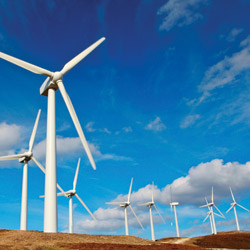
The sustainability movement’s next wave will require the skilled trades.
One of the best ways to frame the sustainability issue can still be found in the simple, forthright words of the United Nation’s 1983 Brundtland Commission, led by former Norwegian Prime Minister Gro Harlem Brundtland. Back then, she and her Commission defined sustainable human activity and development as that which "meets the needs of the present without compromising the ability of future generations to meet their own needs."
A quarter century later, humankind is still struggling to embrace this fundamental concept of sustainability in all that we do here on Planet Earth. The polar regions continue to recede as we pump ever greater quantities of greenhouse gases into the atmosphere. The oceans become ever more dangerously overfished and depleted of their intricate and diverse ecosystems. And, as developing countries turn into developed ones, they produce ever greater magnitudes of consumables that must be used and discarded, often without being properly recycled.
As the sustainability movement becomes more ubiquitous, a new, more optimistic paradigm is beginning to emerge. That paradigm will demand that each of us rethink just about everything we do, in both our personal and our professional lives. And it will ask that we move away from a position of seeking physical dominance over our precious Planet Earth, and more towards the notion of being invited and respectful guests.
As Ms. Brundtland’s sustainable imperative first took hold in the final years of the 20th century, there was what we might call a first wave of sustainability. Thoughts about directly harnessing energy from the wind and the sun (instead of harnessing their long-stored energy in the form of coal, oil, gas and other finite natural resources) took hold. Centuries-old windmills served as the inspiration for the first generation of modern wind turbines. Equally time-tested ideas about heating water through capture of the sun’s rays spurred the development of energy capture via photovoltaic panels. And, the idea of judiciously recycling our products of consumption rather than discarding them in ever-larger landfills also gained acceptance.
The second wave of sustainability is now upon us, and involves some much deeper shades of green. Those smaller wind turbines have been replaced by much larger models that are now being installed both on land and offshore (with the latest experiments involving mobile floating turbines that can travel far out to sea, where some of the best wind capacities can be found). The principles of biomimicry are being employed to consider new solar panel designs that transform the sun’s energies as efficiently as any green plant can. And technologies such as light-emitting diodes are being used to utterly transform how we provide artificial light to our built environments. Technologically, the sustainability movement is in many ways evolving and reaching maturity.
As important as any of these sophisticated technologies, however, is the way we are looking anew at all of our modern-day behaviors and rhythms of living, as part of this second wave. William McDonough’s Cradle-to-Cradle Movement (first brought to light at the turn of the current century) has caused us to re-examine how we design and create everything—from simple, everyday products to whole buildings and complete cities. With the popularity of the New Urbanism and Aging-in-Place movements (to name just two), we are critically rethinking the suburban sprawl model of human habitation and development that took the modern world by storm in the latter half of the 20th century. And, with the USGBC’s all-new 2009 Leadership in Energy and Environmental Design (LEED) standards, a regional requirement has been added that may mark the humble beginning of an utterly different path for economic globalization.
What does this ongoing evolution of the sustainability movement mean to the skilled trades? Plenty. As my colleague in “all things green,” Ginger Johnson, points out elsewhere in this issue, the sustainability movement has created a wealth of new green-collar jobs that require whole new sets of finely-honed, sophisticated skills. As green technology’s second wave further develops and matures, those jobs (and their requisite required skills) will only further develop, evolve and expand.
Of equal impact, the second wave of sustainability will ask that all existing skilled trades profoundly re-examine everything they do. All their current skills, processes and ways of approaching a given task or project will have to be turned on their collective heads in order to make each and every part of a skilled tradesperson’s job as genuinely green and sustainable as possible.
What does this mean for the skilled trades in Peoria and central Illinois? It represents nothing less than a limitless opportunity to take a firm hold of the future and completely reinvent themselves. And, in that process, to make our Peoria community a mecca for the newly sustainable world that is on the horizon.
The skilled trades played a fundamental—and essential—role in the creation and evolution of the complex, high-technology world in which we live today. As we enter a second, more profound phase in the transformation of that world into a truly sustainable one, those same skilled trades must be at the head table, helping to lead the discussion and evolution, so that Ms. Brundtland’s vision of a Planet Earth where our actions and developments “meet the needs of the present without compromising the ability of future generations to meet their own needs” will someday soon become a permanent reality. iBi

